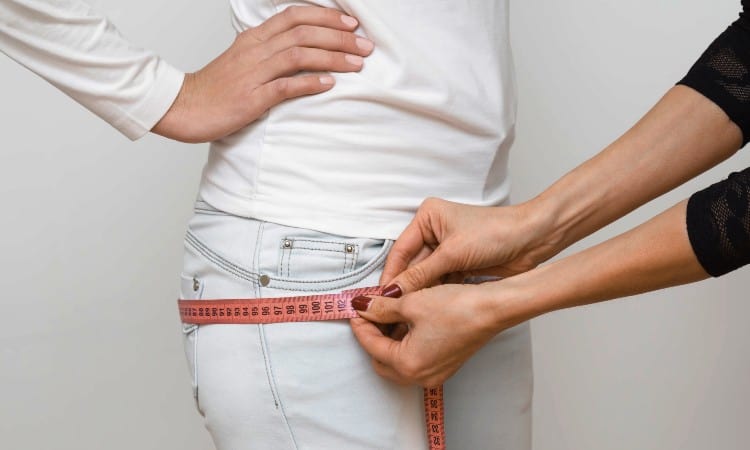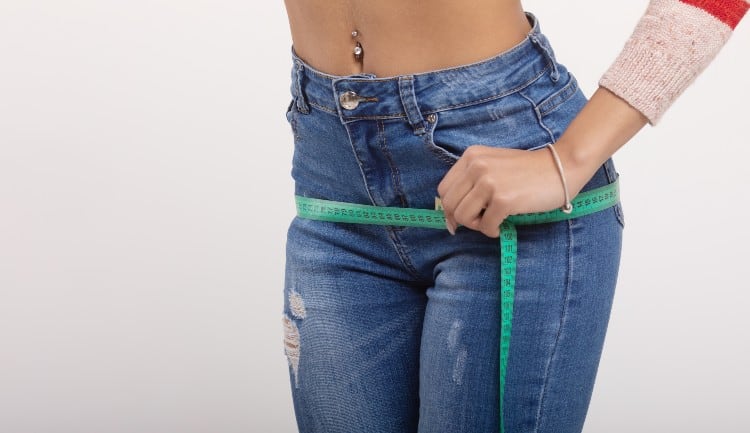If you have ever ordered pants online in your usual size only to find that the waist does not zip shut or the seat bags out on you, you know how hard it is to find clothing that fits you just right! A size ten in one brand may fit you like a glove, while a size ten in another brand makes you look like a kid dressing up in mom’s jeans. The only way around this dilemma is to learn how to measure your hips so you can match your measurements to the sizing charts provided by each brand.
The best way to measure hips is to use a flexible tape measure wrapped around the widest part of the hips and bottom. This area usually falls seven to eight inches below the natural waist. When used with an accurate waist measurement, this provides all the information necessary to buy pants, skirts, or shorts that fit an individual body.
In this article, you will learn how to find your hips and take accurate measurements. You will discover how a hip measurement can help you achieve a healthy body fat ratio. Finally, you will learn about the common hip shapes and how best to style them.

Quick Navigation
- Where Do You Measure Your Hips?
- How to Measure Hips: 5 Methods
- How to Measure Hips for Body Fat
- How Do You Measure Your Hip Size?
- Low Hips vs High Hips
- Low Hip Measurement
- Narrow Hips Meaning
- Hip Measurement Chart
- What is the Average Hip Size for a Woman?
- What is the Normal Size of Hips?
- Different Types of Hips and How to Style Them
- Conclusion
Where Do You Measure Your Hips?
You should measure your hips at the widest part of your lower body. You can often find this point by feeling the pointed tops of your hip bones. You can also find this point by measuring six to eight inches down from your natural waist and using that as the starting point for your hip measurement.
That said, everyone has a slightly different body shape. You may have rounded hips and a curved stomach or slender hips and a rounded posterior. If your body shape makes it difficult to determine the widest portion of your hips, try looking in a full-length mirror.
If you feel comfortable asking for help, you can get a close friend or family member to stand a few feet away. This distance may make it easier for the second person to pinpoint the widest part of your hips.
Once you have located the widest section of your hips and behind, you can follow the simple steps in the next section to learn how to take an accurate measurement!
How to Measure Hips: 5 Methods

Measuring your hips takes just a few simple steps with the help of a flexible tape measure. You can find fabric tape measures in most sewing kits, buy them online, or even locate them at the grocery store!
If you need measurements in a hurry and you do not have a flexible sewing tape measure available, you can also print one out on regular printer paper. You can even use a ruler to measure out inch markings onto a piece of string and use that in place of a tape measure!
1. For Women
The key to getting an accurate hip measurement for women is to measure around the widest portion of both the hips and buttocks. For women, the hips often form the widest part of the body, as women tend to have obviously curved hips. This makes getting an accurate measurement extremely important, as it will determine whether or not your clothes fit your lower body!
- Take off your outer clothes, though you can leave on thin undergarments.
- Position yourself in front of a floor-length mirror with your feet flat on the floor and close together. If you move your feet apart, your hips will shift and you will not get a measurement of your widest hip stance.
- Locate the widest part of your hips and the widest part of your bottom. You may want to ask a friend for help with this! Or look in the mirror and eyeball it yourself.
- Pin one end of the tape measure to the widest point of one hip with your right hand. Hold this firmly in place as you wrap the other end of the measure all the way around your seat and across your front. Make sure the measure remains parallel to the floor the whole way around your body.
- Use your left hand to pinch both ends of the tape measure together where they meet after circling you.
- Note down the number at this pinched point in inches.
2. For Men
The trick to getting a correct hip measurement for men is to realize that your starting point may rest lower on your body than you think. Men often have hips that do not curve out from the line of the body as obviously as women, making finding the widest point more of a challenge.
To get around this, you can locate the ilia, or the point of the hipbones, as these often mark the widest section of the hips. Most of the time, this point falls just a few inches higher than the crotch.
- Once you locate the widest section of your hips and buttocks, begin by standing in front of a mirror and planting your feet flat on the floor right next to each other.
- Wrap a flexible tape measure around the widest circumference of your hip bones and buttocks. Make sure the tape remains level because if it sags, the extra amount of tape will skew your measurement.
- Pinch the two ends of the tape together and note the measurement at this point.
3. On Pants
Measuring a pair of pants that fit you well will provide an approximation of a hip measurement for you. Most pants do not have a skintight fit, so you will get a measurement an inch or so larger than your actual physical size in most cases.
- Spread out the pant on a hard, flat surface like a floor or large table.
- Locate the widest area of the hips. On pants, this usually falls 1 ½ to 2 inches below the top of the zipper. On women’s pants, you will likely see an obvious outward curve in the hips, making it easier to locate the widest point.
- Measure straight across this point and then double your measurement to include both the front and back of the circumference.
4. For Sewing
If you sew your own clothes, taking a hip measurement that includes the shape of the waist can help you get the most accurate hip shape in your garments. This method of measuring does not work as well for ready-made garments because it requires you to adjust the overall shape of the waist in the garment before it is made. But if you know how to sew, this valuable tip can help you create clothes that look tailored to your particular body type!
Most clothing brands use waist and hip measurements in sizing charts. But what if (like many people) you have a tummy that curves past both waist and hips? If this is the case, you know that a curved tummy will distort the shape of a fitted skirt or cause side wrinkles in many pants.
To avoid this issue, measure your hips in this way:
- Find a piece of stiff cardboard as wide as the front of your body. With one hand, hold this flat across the protrusion of your stomach.
- Place your feet flat on the floor and angle yourself in front of a mirror to see what’s happening.
- Next, locate the widest area of your hips and buttocks. Wrap the measure around this circle just as you normally would, with one key difference: as you cross the front of your body, circle the measure over the stiff cardboard. This way, your hip measurement will incorporate a little extra space for the protrusion of your tummy!
- Pinch the two ends of the measure together where they meet and note down this number.
5. Hips and Waist
The easiest way to measure hips and waist is to measure the widest portion of the lower body for the hips and the narrowest point for the waist. This holds true for most body types, though not for all.
If you have a body type that makes it harder to locate your waist, find your navel. Your natural waist should rest just two to three inches above your navel.
Also, it is important to keep in mind that waist and hip measurements describe two different portions of your body. Most sizing charts will ask for both measurements to help you pick the right size of clothing.
This makes sense when you think about it. Suppose you have a 32” waist and 35” hips. If the pants you want in Size 8 have a 32” waist but only 34” hips, you will know that a Size 8 from that brand does not fit your body!
How to Measure Hips for Body Fat

Knowing your hip measurement also helps you understand the health of your own body through a waist-to-hip ratio.
What is a waist-hip ratio and why does it matter? You can find your waist-hip ratio by measuring your waist, then your hips, and then dividing the waist by the hip size.
For example, if you have a 32” waist and 34” hips, you would perform this calculation: 32/34 = 0.94.
Health experts have recently discovered that this ratio provides a better indication of a healthy body than the more traditional BMI, which simply compares your weight to your height. This is because the waist-to-hip ratio shows how much abdominal fat your body carries.
Doctors now know that this particular type of fat can indicate many health concerns like diabetes, heart disease, and even cancer.
For men, a ratio of 0.9 or less is healthy. For women, anything below 0.85 is considered healthy.
How Do You Measure Your Hip Size?
To find the right size of clothes for your hips, take an accurate hips measurement and then compare that number to the sizing chart provided by the clothing brand.
Most brands offer sizing charts online. If you plan to shop in person, read the label on the pants or skirt carefully to find the measurements it lists
That said, you typically need to take several measurements to use a sizing chart effectively. If you want to buy pants, you will need to take waist, hip, and inseam measurements and match your numbers to the sizing chart.
If you plan to buy a dress, you will need waist, hip, and bust measurements at the very least.
If you find that your hips always seem too large for the sizes provided–for instance, if your bust and waist fit a size 6 dress, but your hips fit the size 10 for that brand–you may want to buy clothes that fit your hips and then get the too-large portions of the garment tailored down to fit your waist.
The other thing to note about finding your hip size is that there is no universal sizing. You can’t just say, “I have 40-inch hips, so that means I have size 16 hips.” Every brand uses slightly different measurements, so make sure you read the sizing chart carefully before making a purchase!
Low Hips vs High Hips
Because every person’s body looks a bit different, some people have hip bones that rest higher on the body than others. Understanding whether you have low or high hips can help you dress to accentuate your body in the best light.
If you have high hips, you will find that the top edge of your hip bones lines up pretty close to your navel. In this case, you may want to wear untucked or scoop-necked shirts that add length to the torso. Straight dresses that do not highlight the hips can also look good.
If you have low hips, the top edge of your hip bone falls several inches below your navel. In this case, look for clothes that accent your waist and provide more shape so that you don’t look like one straight line. A-line or flared skirts will also work well!
Low Hip Measurement
You can take a low hip measurement in the same way as you would take any hip measurement–simply locate the widest area of your hips and bottom.
Many people with lower hips also have a slender frame and quite narrow hips, making locating that widest point a bit trickier. One way around this is to look at your rear end in a mirror and use the widest portion of your seat as your starting point instead.
Narrow Hips Meaning
Narrow hips mean that you have a slender bone structure with hip bones spaced close together. There is no specific measurement that divides narrow hips from wide hips, though. It is like the difference between considering someone skinny or rounded–this metric varies from one person’s ideals to another!
Another way to think of narrow hips is that a person with narrow hips will have a bigger chest, bust, waist, or thighs than the hips. If you have narrow hips, hips are not the widest part of your body.
Hip Measurement Chart
This chart will give you an idea of the average waist and hip measurements used by some brands for sizing, though keep in mind that there are no universal sizing rules! These measurements will always vary slightly from one brand to another.
| Size | Waist in inches | Hip in inches |
| 0 | 24 | 30 |
| 2 | 24-26 | 32-36 |
| 4 | 28 | 36 |
| 6 | 29 | 39 |
| 8 | 32 | 40 |
What is the Average Hip Size for a Woman?
The average clothing size worn by women in the United States is a Size 16, which normally has a hip measurement of around 46.5 inches. In comparison, Size 8 clothing for women typically has a hip measurement of anywhere from 38-40 inches.
Of course, exact hip measurements do vary from one brand to another, but the most commonly worn women’s clothing in the United States has a hip measurement of more than 46 inches.
What is the Normal Size of Hips?
The bottom line is that there is no normal size of hips, though you can find recommendations for a healthy waist-to-hip ratio for your own particular body measurements. Most doctors suggest that a waist-to-hip ratio under 0.80 is healthy, so aim for that!
If what you really want to know is “what is an attractive hip size,” the answer becomes more complicated. You can find plenty of stylists online claiming that 32” hips are the only beautiful hips or that anyone with 36” hips is fat. Don’t believe any of them!
The fact is that there is no ideal hip size. Some bodies have hip bones that curve out, and some bodies have more narrow hip bones that don’t curve out. Each body has its own unique beauty, no matter how wide or how narrow its hips!
Different Types of Hips and How to Style Them
Every kind of hips has its own beauty, and you can learn to accentuate that by understanding different types of hips and how to style them.
In general, most hips fall into five basic shapes:
- A-line hips have a gentle diagonal slant from the top of the hip to the bottom. You may want to wear shirts or dresses with belts and nipped-in waists to accent the gentle curve.
- Heart-shaped hips look like half of a heart on the side of the body that curves out and then down like a comma. You may want to play this bold curve for a sexy style by wearing pencil skirts. On the other hand, you can also find yourself prone to muffin tops if you wear skin-tight clothing like leggings with this body shape.
- Square-shaped hips do not have a rounded edge and instead form a straight line down the side of the body. You may want to try clothing that redirects the eye away from that straight line, such as peplum tops or a-line skirts.
- Narrow hips do not protrude from the rest of the body much at all and, in fact, have less width than other portions of the body like the chest. You will want to avoid wearing tube tops or sheath dresses that make you look like a pencil. Instead, look for clothing with shape, like 1950s-style dresses or tunic tops.
- Triangle-shaped hips form a diagonal line out from the top of the hip, and then another diagonal abruptly cuts in toward the thigh. Try to avoid wearing tight clothing like leggings that cling to the triangle part of your hips. Instead, look for loose and flowy garments like long shirts and flouncy dresses.
Conclusion
The best way to measure your hips is to wrap a flexible tape measure around the widest portion of your hip bones and buttocks. Learning how to measure your hips will help you use a sizing chart to buy clothes that fit you correctly. Measuring your hips accurately can also help you avoid medical dangers like heart disease and diabetes as you understand your own waist-to-hip ratio.
While there is no ideal hip size or shape, you can master your own hip style by styling your clothing to fit the curve of your hips. You can also discover whether you have low hips or high hips and wear shirts that best frame the shape of your hip bones.